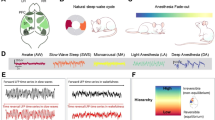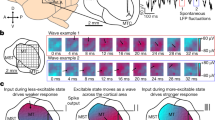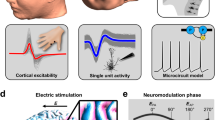Abstract
THE passage of direct current produces changes in the electrical activity of nervous tissue. For example, the polarization of nerve terminals in muscle spindles gives rise to alterations in the membrane potential; a depolarization produces an increased rate of discharge of nerve impulses while hyperpolarization decreases the discharge frequency1. A similar effect can be produced by polarization of the spinal cord2; the discharge in the ventral roots is altered by the passage of small currents across the thickness of the cord.
This is a preview of subscription content, access via your institution
Access options
Subscribe to this journal
Receive 51 print issues and online access
$199.00 per year
only $3.90 per issue
Buy this article
- Purchase on SpringerLink
- Instant access to full article PDF
Prices may be subject to local taxes which are calculated during checkout
Similar content being viewed by others
References
Lippold, O. C. J., Nicholls, J. G., and Redfearn, J. W T., J. Physiol., 153, 209 (1960).
Fuortes, M. G. F., J. Physiol., 126, 494 (1954).
Bindman, Lynn J., Lippold, O. C. J., and Redfearn, J. W. T., J. Physiol., 162, 45P (1962).
Author information
Authors and Affiliations
Rights and permissions
About this article
Cite this article
BINDMAN, L., LIPPOLD, O. & REDFEARN, J. Long-lasting Changes in the Level of the Electrical Activity of the Cerebral Cortex produced by Polarizing Currents. Nature 196, 584–585 (1962). https://doi.org/10.1038/196584a0
Issue Date:
DOI: https://doi.org/10.1038/196584a0



